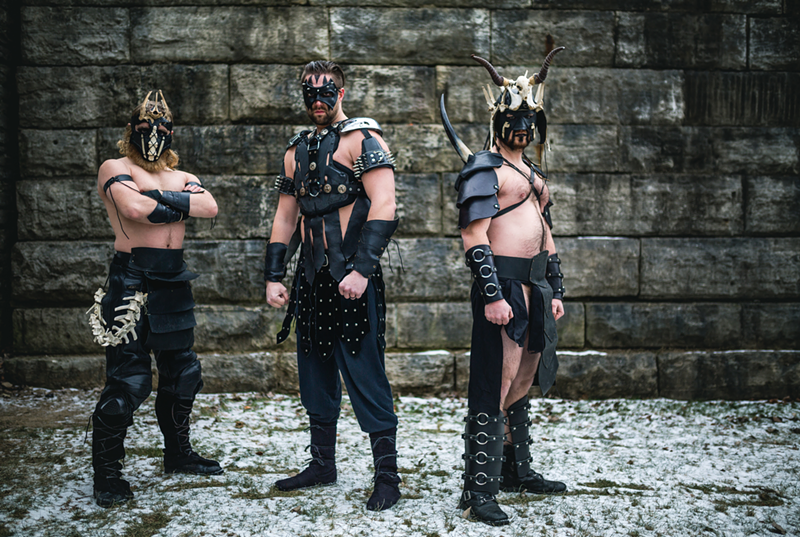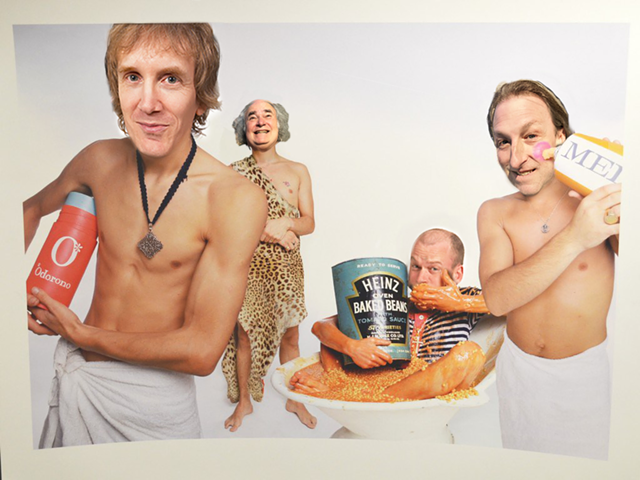As any attendee of the Cincinnati Entertainment Awards will tell you, many of Cincinnati’s musical elite have eccentric fashion sensibilities. But at the most recent ceremony this past November, even those hardened by years of musical debauchery were caught off guard by Cincinnati-based Heavy Metal trio Siegelord’s choice of garb. The musicians’ attire of black leather, steel, animal bone and fancy tuxedo shirts caught many eyes, including those of the CEA mavens of fashion, The Fairmount Girls, who host the annual “Fashion Trashies” in conjunction with the awards show. For many, it was a shock to see the band members’ aggressive and silly ensembles, but Siegelord fans were stunned by one specific sartorial choice by vocalist and bassist Ulfr — he was wearing a shirt for once.
The members of Siegelord — Ulfr, drummer Sieven and guitarist Therod — have pronounced themselves “Cincinnati’s Most Shirtless Band,” but beneath the lack of sleeves is a group that has managed to craft a compelling, unique narrative and marry it to real-life stories of struggle. The trio has flourished under grim circumstances — namely leaving a highly successful local act, setting out on their own, struggling to find their sound and winning back fans that had written them off after the exodus.
“Between December and January of 2012 and 2013, Sieven, Warg (Siegelord’s original bassist and a founding member) and myself left (Northern Kentucky-based Folk Metal act) Winterhymn, and as early as March, the three of us began rehearsing new material,” Ulfr says. “There wasn’t exactly a clean falling out so we wanted to get back into the music because we all felt that we had left part of us behind. In the shadow of Winterhymn, we really wanted to try something different. We had come from this semi-cinematic, costumed band with lots of non-traditional instruments in Metal and the crazy live shows, so we wanted to break away from that and do some more traditional Heavy Metal.”
The band’s attempt to recreate themselves after leaving led them to trade in leather for denim and abandon the symphonic elements that give Winterhymn such a unique sound. But the trio quickly realized they were creatively unsatisfied and that Cincinnati’s Metal fans were not receptive to the new direction.
“It might not have been going back to square one but it was pretty damn close,” Ulfr says. “I wouldn’t say we lost respect from people, but we definitely didn’t gain it. And I feel like a lot of people could sense we weren’t being true to ourselves because it was better received when we went back to what we’re good at.”
“We enjoy melody but we all had a fascination with dark sound, atmosphere, a lot of Black Metal influence and bringing that to a melodic light and reinforcing the dark fantasy,” Sieven says.
In March of 2015, guitarist Therod joined the band and Siegelord trudged forward to complete its first full-length, Ascent of the Fallen. The album is a 12-song concept work that tracks the members’ alter egos (the same as they had in Winterhymn) as they are cast out of their home realm and into a barren wasteland, where they embrace their new condition and, with the help of the fallen god Ang Ul-Mak the Siegelord, thrive in this new world.
On its surface, Ascent is a traditional dark fantasy with characters and a mythos that can stand independently of the men behind the protagonists. But knowing the true story of Siegelord gives insight into the album’s lyrics.
“Our characters are based off of real-life experiences,” Therod says. “A lot of it is coming from trying to break out of difficult places or (the) self-realization that you don’t like who you are and what you’re doing and trying to make yourself better.”
“We had these personas and these characters already, so it made sense to use that because those were our identities,” Sieven adds. “Even if they were a part of Winterhymn, they were actually part of our identity as well, so it made sense to keep that.”
The story and characters developed just as the members did during Ascent’s writing and recording.
“The whole concept of the album changed and evolved over time as we decided how many songs we were writing, what songs (to use), the order on the album; then we picked up a member so we had figure out how to feed his story into the rest of the lyrical content,” Ulfr says. “It was definitely a challenge, but it’s something I’m very proud of and very eager to keep pushing forward.”
While the band presents a serious, heavy-hearted front on Ascent, its live show is decidedly more fun.
“We definitely have personalities live, but we don’t take ourselves seriously,” Ulfr says. “Nobody enjoys themselves when they go to a show and everyone is just mean-mugging the whole time, like the band has a stick up their ass, making some sort of artistic statement about how pissed off they are. The story we tell, the lyrics we do and the music we write is all very serious and, in a vacuum, it’s pretty dark and brutal; all the guys are brooding guys with a chip on their shoulder. But live we make jokes about ourselves so there’s a break in the suspension of disbelief.”
This desire to buck expectations is carrying over to Siegelord’s upcoming release as well: The band intends on continuing the tale of its characters on a new full-length, but are close to completing a four-track EP that should be released in the coming months. With covers of songs by Mastodon, Immortal and Amon Amarth, the EP spotlights the band’s influences, with one notable exception — a version of Leonard Cohen’s “Hallelujah.”
“I wanted all the lyrics (of the cover songs) to apply to our mythos,” Ulfr says. “As an artist, I get really bored with bands that cover songs in their same genre. I think that having such a unique sound, it’s a very cool way to rework fan favorites but offer something new.”
“We deconstruct ourselves in that song,” Therod says of “Hallelujah.”
Siegelord’s “Hallelujah” uses each verse to highlight the band’s essential elements. The first three borrow heavily from Doom, Black Metal and Thrash before cutting out the instruments and letting Ulfr carry the final verse, ending the track with a crashing crescendo.
Having a costumed Metal band cover a muted hymn is a gamble, but Siegelord’s drive to nail the song exemplifies the trio’s work ethic as a whole. The musicians have fought through a rocky start, working to gain respect from their old bandmates and the Heavy Metal scene as a whole. They’ve toiled through lineup changes and stuck to their guns to create an ambitious concept album for their very first recording. They crowned a covers EP with an unexpected song choice, which they made undeniably their own. They put their fists up against destiny and landed a haymaker square on its jaw. Now they’re focusing on landing the follow-up shot.
“The message of the band is not just survival, but thriving,” Ulfr says. “Not just getting by, but beating it and truly embracing life.”
For more on Siegelord, visit facebook.com/siegelord.







